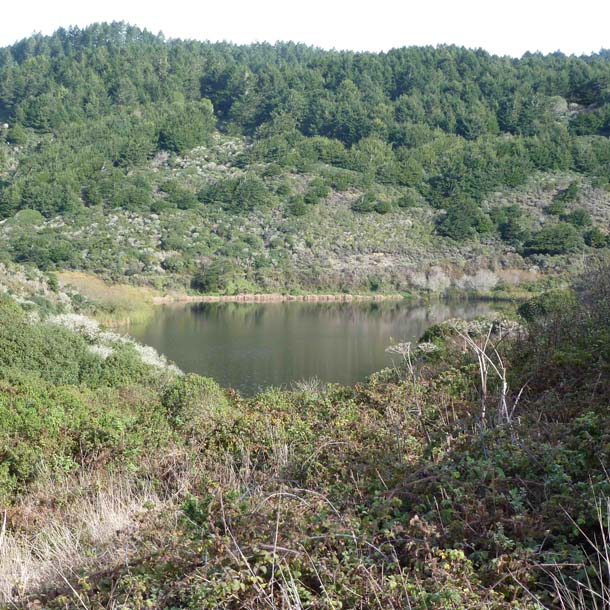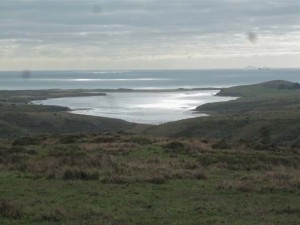This is part of a year-long effort to hike every trail at Point Reyes National Seashore, which turned 50 in 2012. Learn more.
Five Brooks to Ocean Lake Loop and Alamere Falls, December 8, 2012. (18 miles RT)
Perhaps truth depends on a walk around the lake. —Wallace Stevens.
This was a long traverse of the mid-peninsula from Five Brooks Pond to Alamere Falls and back, about 9 miles each way. I had covered much of distance on previous hikes, but retracing one’s steps is a necessary hurdle when covering all the trails. The first clearing in a series of storms that baptized the region over the previous week seemed like an opportune time to hike to one of the peninsula’s most remote destinations—Alamere Falls. The falls should be fully charged after the deluge.
Five Brooks at dawn is always enchanted at first light, before too many bipeds have spooked the wildlife. This morning, however, with a shroud in morning mist, all was quiet and still.
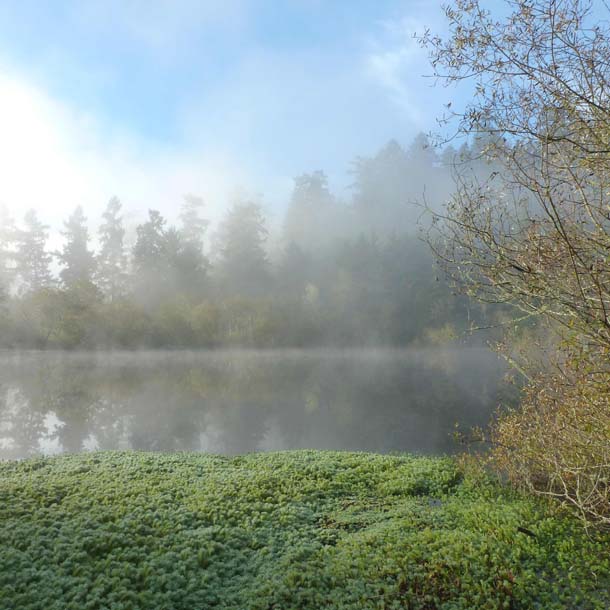
Along the east slope of Inverness Ridge the Stewart Trails switches back-and-forth up a long grade through damp mixed-evergreen forest. The death of tanoaks caused by the sudden oak death within the forest has provided abundant deadfall and many standing snags. Shortly after I start up the trail, a pair of Pileated Woodpeckers calls back-and-forth to one another. These are big raucous birds (listen here), but they move through the shadows, and apparently aware of my presence, they stay on the far side of every tree, so are impossible to photograph. Farther along, a coyote darts out from behind a massive old fir, kreebles across the trail, pauses to consider me, then lopes up the trail. Just a few decades ago, this “song dog” was absent from the peninsula; now it his common, encountered on almost every outing, especially in the low light hours.

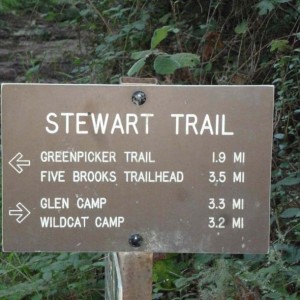
The habitat is fairly uniform as you ascend the east slope of the ridge. Near the top the trail branches and the route to the coast climbs through a even-aged stand of fir, probably clear-cut in the 1950s and early 1960s when Sweet Lumber ran an operation at Five Brooks. Nearing the ridge I enter an inversion zone where it’s about 10 degrees warmer than in the Olema Valley below. Here the forest is alive with the constant chatter of insectivorous birds—kinglets, creepers, chickadees—but the most common sound is the insistent and incessant “yank-yank-yank” call of the Red-breasted Nuthatch (listen here).
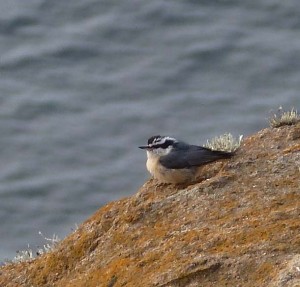
This winter has been an “irruptive” year for this little seedeater of the boreal forest, with larger numbers showing up here in the fall and overwintering. These population upsurges tend to occur every two to four years when conifer cone production in the northern boreal forests is poor. This has also been a banner winter for Townsend’s and Hermit warblers, other birds of the boreal forest (though insect-eaters), and I wonder if the similar conditions influence each species.After cresting the ridge and descending the coastal slope, the ocean suddenly reveals itself through a cleft in the landscape, always a welcome and pacifying sight.

It’s a long, steep grade down to Wildcat Beach where the Stewart Trail intersects the Coast Trail. At Wildcat (Walk-in) Campground the Ocean Lake Loop cuts off to the south. This is new territory for my “2012 Walkabout,” and leads to the final destination—Alamere Falls. I’ve waited until poison oak is in its dormant phase to attempt the narrow trail that spurs off the Ocean Lake Loop down to the falls, and am pleased to be arriving when the feeder stream is fully running.
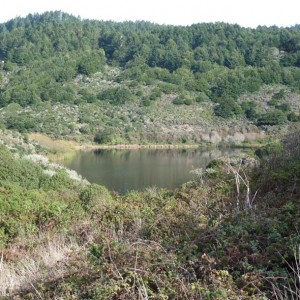

After skirting the lake, a steep spur trail leads down to the foot of Alamere Falls (0.4 miles). The last few hundred feet are treacherous due to the flaking shale and the precipitous incline—not advisable for the faint of heart, or footing.
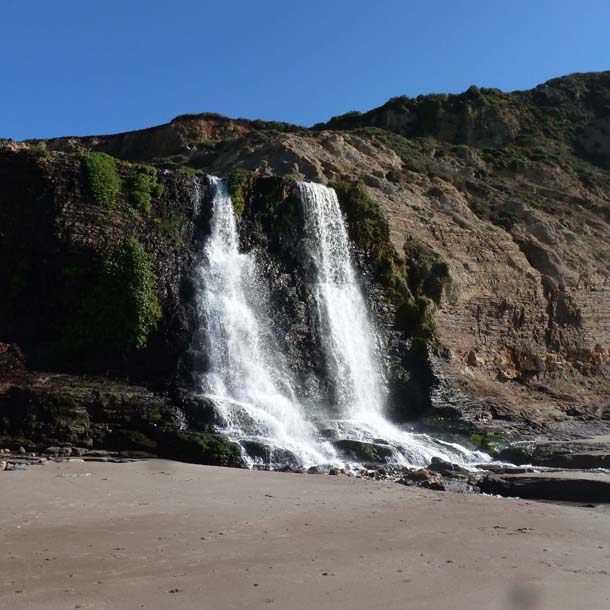
Other hikers have gravitated to the falls this clarion day, and perhaps a dozen folks, are lounging on the beach, eating lunch and simply relaxing. What is it about running water that so captivates us?
Nothing in the world is more flexible and yielding than water. Yet when it attacks the firm and the strong, none can withstand it, because they have no way to change it. So the flexible overcome the adamant, the yielding overcome the forceful. Everyone knows this, but no one can do it. —LaoTzu
Thoroughly soothed by the sound and sense of the falls, I begin a slow walk along the beach, recently sculpted smooth by a receding tide. The beach is mostly barren; though a few seastars that have been cast shoreward by the waves and decorate tideline. Although sea stars have few predators in their preferred subtidal rocky shore habitat, once stranded ashore they become vulnerable to gulls that, amazingly, don’t seem hesitant to swallow them whole. A first year (“2012 model”) Glaucous-winged Gull walks along the tideline with one protruding from his beak, a meal that must be difficult to digest, given that the creature is an echinoderm, literally “spiny skinned.”
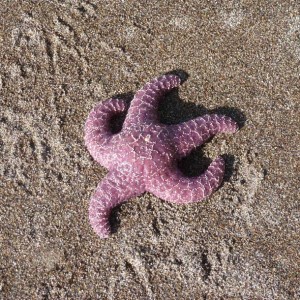
It’s a little over a mile back to Wildcat Camp. As I approach I lift my binoculars to watch a Black Phoebe fly-catching over one of the kelp tangles on the upper beach. Phoebes, pipits, and shorebirds commonly feed on the beach jumpers and kelp flies associated with decomposing kelp, but I’m surprised to see a warbler pop-up in my field of view. This is the first time I’ve noticed a woodland warbler on the beach, so I’m further surprised and delighted when I notice a half dozen Townsend’s Warblers in another tangle of wrack about one hundred yards farther along. (I posted this sighting on North Bay birds and heard from several other people of similar sightings, from Bolinas to Bodega.)
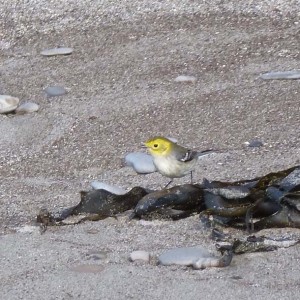
Time to retrace my steps back to Five Brooks. The memories of several unexpected encounters give me some truth to mull over on the return trip—warblers on the beach, the quiet peacefulness of still ocean lakes, delicate mushrooms, and the energizing surge of fully charged falls at Alamere.
Acknowledgements: Thanks to Bob Stewart for mushroom identification and to Steve Howell, Gene Hunn, Susan Kelly, and Peter Pyle for responses to my query about “warblers on the beach.”
Critter List
Birds
Surf Scoter
Bufflehead
California Quail
Pacific Loon
Common Loon
Pied-billed Grebe
Horned Grebe
Red-necked Grebe
Western Grebe
Brown Pelican
Brandt’s Cormorant
Double-crested Cormorant
Turkey Vulture
Red-tailed Hawk
Virginia Rail
American Coot
California Gull
Herring GullThayer’s Gull
Western Gull
Glaucous-winged Gull
Band-tailed Pigeon
Acorn Woodpecker
Downy Woodpecker
Hairy Woodpecker
Northern Flicker
Pileated Woodpecker
Black Phoebe
Steller’s Jay
Western Scrub-Jay
Common Raven
Chestnut-backed Chickadee
Bushtit
Red-breasted Nuthatch
Pygmy Nuthatch
Brown Creeper
Bewick’s Wren
House Wren
Winter Wren
Marsh Wren
Golden-crowned Kinglet
Ruby-crowned Kinglet
Hermit Thrush
American Robin
Varied Thrush
Wrentit
Yellow-rumped Warbler
Townsend’s Warbler
Hermit Warbler
Common Yellowthroat
Spotted Towhee
California Towhee
Fox Sparrow
Song Sparrow
White-crowned Sparrow
Golden-crowned Sparrow
Dark-eyed Junco
Purple Finch
Mammals
Coyote
Black-tailed Deer
Sonoma Chipmunk
Brush Rabbit
California vole (in talons of Red-tailed Hawk)
Mountain Lion (scat)
Bobcat (scat)
Dusky-footed Woodrat (lodge and scat)

